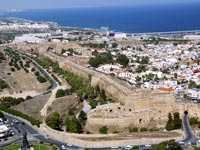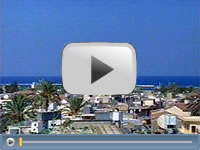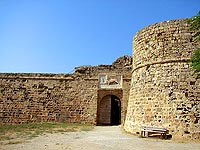
Famagusta City Walls in Famagusta, North Cyprus.
 |
the north cyprus travel guide |
 |
|
Famagusta City Walls
At the height of its wealth and status in the 1300s, the walls around the North Cyprus town of Famagusta certainly had plenty to defend. The Lusignan kings first fortified the city of Famagusta, followed by the Venetians who made the town even more secure by replacing the square towers with round ones. They also widened and increased the height of the original Lusignan walls, which were not designed to deflect cannon fire. It is said that none other than Leonardo da Vinci advised on the construction of the walls of Famagusta, when he visited the North Cyprus in 1481. The result of all this reinforcement remain today, city walls up to eight metres thick and fifteen metres wide, and a fascinating old city lying inside them. The Siege of Famagusta, Northern CyprusHowever, ultimately, the walls of Famagusta could not withstand the fire power and artillery of the Ottoman Turks, who besieged the city in 1571. Legend says that the Ottomans threw over 100,000 cannon balls at the city during the siege, and you can still see them dotted around today. The moat did little to deter the Turks either; you can still see it today, surrounding the three land-facing sides of the walled city of Famagusta. Above the moat, the walls rise in stately splendour, and you can even drive along the base of the walls of Famagusta in the moat, with a little care to avoid the rubbish that tends to fall onto the track! A stroll along the moat of Famagusta takes about an hour, but don't try it in the heat of summer - no breeze reaches the bottom of the moat so it would be a long, hot walk.
The Walls and Bastions of Famagusta, North CyprusThe walls form a rough rectangle around the city, and comprise of a series of bastions, many retaining their Venetian names. Clockwise from the Ravelin Bastion and Land Gate, one of only two original gates in the walls, you will find the Diocare, Moratto, Pulcazara, and San Luca Bastions on the west wall, with the Martinengo Bastion on the corner. However, be aware that this section of the city and walls is a military zone, and you cannot walk along the walls or inside the zone except to visit four churches. Otello's Tower in Famagusta, North CyprusPast the Del Mezzo Bastion on the north wall is a gate, opened by the British to allow more traffic into the walled city. At the Diamante Bastion, the Famagusta walls turn to face the sea, leading to the Signoria Bastion which overlook the football pitch and former polo field. Next is the Famagusta Citadel, or Othello's Tower, which overlooks the modern sea port and the original Sea Gate. A long stretch of straight(ish) wall leads to the Canbulat Gate (another British opening) and the Canubulat Basion, which houses a museum. Then the walls turn inland back to the Land Gate via the Camposanto, Andruzzi, and Santa Napa Bastions.
The Ravelin, Famagusta, Northern CyprusThe southwestern Land Gate is protected by the impressive Ravelin, itself protected by its own moat. The Ottomans called it the "White Tower", as it was from here that the Venetians waived the white flag of surrender during the siege. Read more about Ravelin. Historic Famagusta TodayThe historic centre of Famagusta has been restored since 1996, and the pedestrianised centre is now an attractive area to wander, shop and gaze. You can drive into the old walled city, but it's best to park the car as soon as possible and explore the rest of Famagusta's inner heart on foot. The walls and buildings exist in a state of graceful decay, not surprising when you realise that vast amounts of stone and building material was plundered from Famagusta to build Alexandria and the Suez Canal in Egypt! |
|
North Cyprus quick: holidays | flights | hotels | property | kyrenia | famagusta | photos | map | weather | history | news
All text is copyrighted by Cyprus44. Photographs are copyrighted by their respective photographers.
For more information read our copyright policy, privacy policy and disclaimer.
This web page is served on 18 September 2025 at 11:28:00 AM.
![]()
Cyprus44 in other languages: Nordzypern | Chypre Nord | Severní Kypr | Северный Кипр
partner sites: goNorthCyprus Travel | Pacific Rent-A-Car | Amy Holiday Villas | other partner sites










